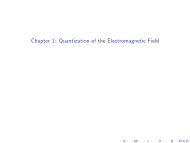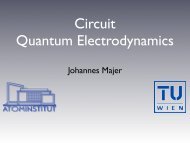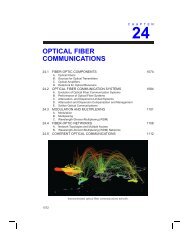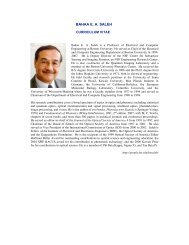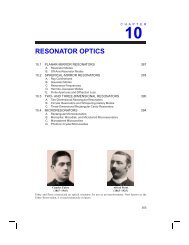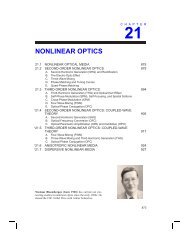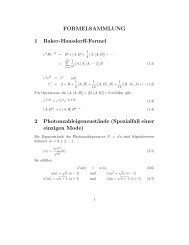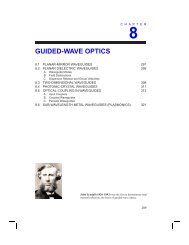nature.com Physicists bid farewell to reality? Seite 1 von 4 ... - CoQuS
nature.com Physicists bid farewell to reality? Seite 1 von 4 ... - CoQuS
nature.com Physicists bid farewell to reality? Seite 1 von 4 ... - CoQuS
Create successful ePaper yourself
Turn your PDF publications into a flip-book with our unique Google optimized e-Paper software.
news @ <strong>nature</strong>.<strong>com</strong> - <strong>Physicists</strong> <strong>bid</strong> <strong>farewell</strong> <strong>to</strong> <strong>reality</strong>? - Quantum mechanics just g...<br />
http://www.<strong>nature</strong>.<strong>com</strong>/news/2007/070416/full/070416-9.html<br />
<strong>Seite</strong> 2 <strong>von</strong> 4<br />
19.04.2007<br />
Assistant / Associate<br />
Professor<br />
Education<br />
NVCI<br />
Las Vegas, NV<br />
More science jobs<br />
Feedback<br />
About this site<br />
About us<br />
For librarians<br />
TOP STORIES<br />
<strong>Physicists</strong> <strong>bid</strong> <strong>farewell</strong> <strong>to</strong><br />
<strong>reality</strong>?<br />
18 April 2007<br />
Full fossil found for the<br />
earliest trees<br />
18 April 2007<br />
Orangutans have it easy<br />
18 April 2007<br />
Changes <strong>to</strong> pesticide<br />
spraying could reduce<br />
GM harm<br />
18 April 2007<br />
Should kids take<br />
antidepressants?<br />
17 April 2007<br />
Decades needed <strong>to</strong> tell<br />
whether ocean currents<br />
are slowing<br />
17 April 2007<br />
Tales of the expected<br />
17 April 2007<br />
Dark matter looks <strong>to</strong> be<br />
particularly wimpy<br />
17 April 2007<br />
mechanics in the early twentieth century. The theory seemed <strong>to</strong><br />
show that, in the quantum world, objects are defined only<br />
fuzzily, so that all we can do is work out the probability that<br />
they have particular characteristics — such as being located in a<br />
specific place or having a specific energy.<br />
Allied <strong>to</strong> this assault on <strong>reality</strong> was the apparent prediction of<br />
what Albert Einstein, one of the chief architects of quantum<br />
theory, called 'spooky action at a distance'. Quantum theory<br />
suggests that disturbing one particle can instantaneously<br />
determine the properties of a particle with which it is<br />
'entangled', no matter how far away it is. This would violate the<br />
usual rule of locality: that local behaviour is governed by local<br />
events.<br />
We have a little more<br />
evidence that the world<br />
is really strange.<br />
An<strong>to</strong>n Zeilinger<br />
University of Vienna<br />
Failed test<br />
Einstein could not believe that the<br />
world was really so indeterminate.<br />
He supposed that a deeper level of<br />
<strong>reality</strong> had yet <strong>to</strong> be uncovered —<br />
so-called 'hidden variables' that<br />
specified an object's properties<br />
precisely and in strictly local terms.<br />
In the 1960s the Irish physicist John Bell showed how <strong>to</strong> put<br />
locality and realism <strong>to</strong> the test. He deduced that if both ideas<br />
applied <strong>to</strong> the quantum world, then two particular quantities<br />
calculated from measurements made on a pair of entangled<br />
pho<strong>to</strong>ns would be equal <strong>to</strong> one another. If so, there would be<br />
nothing 'spooky' about entanglement after all.<br />
Experiments were done <strong>to</strong> test his prediction in the ensuing two<br />
decades, and results showed that Bell's equality was violated.<br />
Thus, either realism or locality, or possibly both of these ideas,<br />
do not apply in the quantum world.<br />
But which is it? That's what Zeilinger, based at the University of<br />
Vienna in Austria, and his colleagues tried <strong>to</strong> find out.<br />
They came up with a similar test <strong>to</strong> Bell's, <strong>to</strong> see whether<br />
quantum mechanics obeys realism but not locality. Again the<br />
experiment involves <strong>com</strong>paring two quantities calculated from<br />
measurements on entangled pho<strong>to</strong>ns, <strong>to</strong> see if they are equal.<br />
But whereas in Bell's test these quantities are derived from the<br />
so-called 'linear' polarization of the pho<strong>to</strong>ns — crudely, whether<br />
their electromagnetic fields oscillate in one direction or the<br />
other — Zeilinger's experiment looks at a different sort of<br />
polarization, called elliptical polarization.<br />
Like Bell's, Zeilinger's equality proved false. This doesn't rule<br />
out all possible non-local realistic models, but it does exclude an<br />
important subset of them. Specifically, it shows that if you have<br />
a group of pho<strong>to</strong>ns that all have independent polarizations, then<br />
you can't ascribe specific polarizations <strong>to</strong> each. It's rather like<br />
saying that you know there are particular numbers of blue,<br />
white and silver cars in a car park — but it is meaningless even<br />
<strong>to</strong> imagine saying which ones are which.<br />
Soil May<br />
Buckybal<br />
100-Year<br />
Climate Z<br />
Never Se<br />
Beyond IQ<br />
Can Focu<br />
Hand Do<br />
Battling B<br />
Protein<br />
more sc



